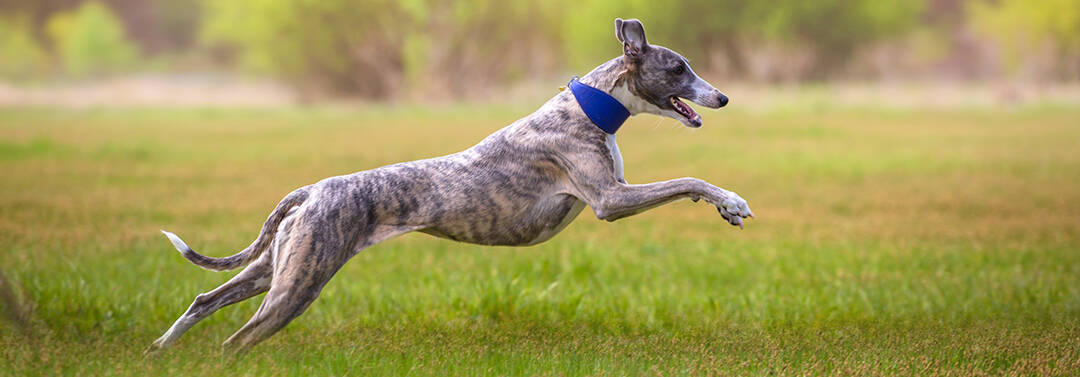
Table of Contents
A Brief History
The development of the Whippet began in England during the mid to late 18th century although Whippet-like dogs were depicted in art as far back as the Middle Ages. Coal miners and other working-class folks immensely enjoyed the thrill of Greyhound sports such as racing, but couldn’t afford to feed and house the large breed. The solution was to create a miniature version – the Whippet.
By breeding small Greyhounds and occasionally mixing in Terriers for toughness and Italian Greyhounds for elegance, breeders were able to produce incredibly fast, delicate-looking dogs with small stature and keen hunting abilities. The “poor man’s Greyhound”, the Whippet, was born.
The Whippet was originally used to hunt rabbits, hares, and pesky vermin; though racing and sports were popular too. The Whippet is often called a “snap dog,” a term referring to contests which involved dogs competing to “snap up” the most rabbits from an enclosed space. The Whippet was recognized by the American Kennel Club (AKC) in 1888 and remains popular today both as a companion and sporting dog.
Whippet Temperament
Whippets are famous for their calm, quiet, sweet-natured, and friendly personalities. These gentle dogs are undemanding, intelligent, and love to be close by their owners (they’re often called “Velcro dogs” for this reason).
Originally bred for the ability to think for themselves while hunting, today’s Whippets can still be independent thinkers, though they are not known to be stubborn. Training can be a bit challenging but can be accomplished with lots of positive reinforcement and patience.
Because of the lack of internal cushioning (fat), Whippets love to lounge on soft, plush furniture. Lying on a hard floor simply isn’t comfortable for this breed, and who can blame them?
Is a Whippet a Good Family Dog?
The affectionate Whippet is an excellent family dog. They are known for being energetic and playful outside and calm and quiet inside. Whippets enjoy being clean, so are typically easy to housebreak and aren’t prone to drooling or digging.
This non-aggressive breed loves cuddles, easily makes friends with strangers, and gets along quite well with other dogs.
Is a Whippet Good With Kids?
This breed is usually very good with children, particularly if they have been raised together. As long as the children are gentle and relatively quiet, the Whippet will be a great companion. In fact, when play becomes too loud or rough, a Whippet is more likely to find a hiding spot than he is to snap at a child.
One thing to look out for when a Whippet is playing with children is that whip-like tail. Little ones are often just the right height to be smacked in the face by a happily wagging tail.
Whippet Physical Traits
The lean, curvy Whippet does indeed resemble a Greyhound, though is smaller. Sporting a deep chest, tucked-in waist, and long graceful legs, the Whippet is the picture of elegance and speed. The long, arched neck and slender head are well balanced with the rest of his body, which is slightly longer than is tall.
Size
The original creators of the Whippet didn’t want a large dog who required lots of space and piles of food; nor did they want a very small dog who could be easily stepped on in a busy household and unable to hunt effectively. The result of their efforts was the perfect compromise.
According to AKC breed standards, Whippet males will be 19 – 22 inches tall at the withers while the females will run between 18 – 21 inches.
Weight
Whippets are often found curled up on their owner’s lap or stretched out beside them in bed, so it is fortunate that this snuggle-loving breed does not grow to be very heavy.
The AKC standards dictate that Whippet males should weigh between 25 – 40 pounds. Females of the breed should be at least 20 pounds but not more than 35.
Coat
The coat of a Whippet is short and sleek. A wide variety of colors are acceptable and include blue, black, fawn, red, brindle, and cream or any of these colors paired with white. Different degrees of shading in these colors are possible and acceptable as well.
Many varieties of markings are common such as saddle, masks, brindle, sabling, ticking, and watermarking. The amount of white can vary greatly and can range from almost none to near-total coverage.
Do Whippets Shed?
Like all dogs, Whippets do shed, though the short hair is not likely to create massive tumbleweeds around the house. Shedding will be more noticeable for a few weeks each spring as the heavier winter coat is lost. Some dogs will experience another seasonal shed in the fall as the summer coat makes way for the warmer winter one.
Whippet Care and Maintenance
Owning a Whippet is not quite all fun and games. All dog owners have a responsibility to provide quality care including proper socialization, routine grooming, sufficient physical and mental exercise, and proper nutrition.
Whippet Socialization
Even naturally friendly dogs like the Whippet still need to be properly socialized, but what exactly does that entail?
Socialization is the process of accustoming a dog to the world around him by introducing him to as many new experiences and situations as possible. Socialization enables a dog to navigate life with confidence and become a well-adjusted adult.
Puppies undergo a period of rapid mental development and awareness between the ages of 2 – 4 months. Ideally, this is when the vast majority of socialization should take place. However, socialization should not end there. Dogs should continue with socialization throughout their lives as they encounter new people, places, and circumstances.
For socialization to be successful, Whippets should be introduced to a wide variety of experiences. Things like dog-friendly stores, outdoor cafes, and playgrounds should all be introduced in a positive way. Meeting new people, becoming familiar with loud noises like vacuums and lawnmowers, and gaining skills such as navigating a busy city sidewalk (on a leash of course) are all critical to a dog’s mental development.
The more introductions and greater range of experiences, the better, for a well-socialized Whippet will have the skills and self-assurance necessary to confidently approach life without fear and shyness. Learn some great ways to socialize your dog and get our 80-point Checklist, in this article.
Do Whippets Need to Be Groomed?
A Whippet’s grooming requirements are minimal compared to other breeds, though some basic grooming will still be necessary to keep a Whippet in tip-top shape and looking his best.
A thorough brushing once a week will help to remove shed hair and evenly distribute the coat’s natural oils, though a Whippet undergoing a seasonally shed will benefit from daily brushing.
Nails will need to be trimmed once or twice per month, depending on the individual dog and if he frequently walks on pavement. Tooth care is important also, and brushing two or three times a week is recommended. To prevent infections, routine ear cleaning should take place every other week or so.
Grooming a Whippet is an ideal time to check for any injuries and anything unusual. This active breed’s coat doesn’t offer much protection from scrapes and cuts as he darts around in play, so check often for wounds.
How Often Should You Bathe a Whippet?
Too many baths can strip a dog’s skin of protective oils, leaving it dry and prone to irritation. Using a quality, soap-free, dog shampoo will help greatly. There is no need to stick to a set schedule. Bathe them if they are visibly dirty or if they’ve rolled in something nasty, like mud (or worse). A Whippet’s short, sleek coat doesn’t trap much dirt and grime, so “doggy” odor isn’t usually a problem.
How Much Exercise Do Whippets Need?
Whippets may look like they are capable of running for hours on end, but in reality, they are sprinters, not long-distance runners and only need a total of about 40 minutes of exercise daily.
A Whippet’s daily exercise needs can easily be met with a couple of short, lively walks and an active, engaging playtime in the backyard or one lengthy play session involving plenty of running.
The desire to run free is deeply ingrained in a Whippet; after all, that is what he was bred to do. A whippet should be allowed to run off-leash (in a securely fenced area) daily to satisfy his need for speed. Whether it’s chasing after a tennis ball, playing tag with another dog, or simply zooming around the yard, let this dog run.
For this reason, it’s ideal that a Whippet have a fenced-in yard.
Any dog (yes, even a Whippet) who does not receive an adequate amount of daily exercise can resort to bad behaviors such as chewing up couch cushions or becoming nuisance barkers. In situations like this, the fault lies with the owner, not the dog. Whippets need to be exercised regularly.
Two important notes:
When not in a fenced location, a Whippet should be kept on-leash due to their strong prey drive. No matter how well trained, the instinct to chase furry critters may take over and a Whippet off- leash may vanish at an astounding speed of 35 miles per hour.
While swimming is terrific exercise for many dogs, this is not the case with Whippets. They don’t have enough fat to aid in buoyancy and keep them warm enough. A quick dip on a hot day may be alright though; just use a dog life jacket for safety. Here’s our favorite swimming vest.
Mental Stimulation
Whippets are an intelligent breed and can fall prey to boredom when not often challenged mentally. Games like hide-and-seek or follow-the-treat-trail are a great way to stimulate a Whippet’s mind and make the exercise fun. We talk a whole lot more about Mental Stimulation, in this article.
Going for a walk on a different route can be mentally stimulating as the dog’s senses are tantalized and his mind is thrown into overdrive. There are many puzzle games and interactive toys which can provide a challenge and reward with treats. Here are some of the most popular dog puzzles on Amazon.
Training sessions can also be mentally invigorating. Teaching basic obedience and fun tricks not only provides a mental workout but also can be a bonding experience as the Whippet learns to view the owner as a leader and friend.
Food and Nutrition
A high-quality dog food, preferably one with meat as the first ingredient, will meet a Whippet’s nutritional needs. With careful research and guidance from a veterinarian, meals prepared at home containing a wide variety of meat, vegetables, fruit, fats, and grains can be a healthy alternative.
Health Issues
Many genetic health issues frequently occur in purebred dogs; however, the Whippet is considered to be one of the healthiest breeds. In fact, old age is the most common cause of Whippet death.
Do Whippets Have Health Issues?
There are a few conditions that have been seen in Whippets that potential owners should be aware of. Keep in mind that these issues are merely possible and not very likely.
Deafness in one or both ears has occurred in Whippets. Eye conditions such as cataracts, Progressive Retinal Atrophy, corneal dystrophy, and primary lens luxation have been identified as well.
A recent concern in the breed is heart conditions such as heart valve disease, murmurs, and irregular heartbeats. Other uncommon conditions include Von Willebrand’s disease (a bleeding disorder), and hypothyroidism.
Responsible breeders will routinely screen their dogs for genetic disorders and should provide documentation of heart evaluations from the Orthopedic Foundation for Animals and eye clearances from the Canine Eye Registry Foundation.
Due to the rather thin coat and lack of body fat of Whippets, they can’t tolerate cold weather for long. A sweater is often needed to keep them comfortable.
Important!– Whippets can be unusually sensitive to anesthesia and other medications. Be certain that the veterinarian is familiar with Whippets’ sensitivities.
Roles: What Are Whippets Best Suited For?
Whippets excel in sports which involve chasing after a fast-moving object at great speed. Flyball, lure coursing, and racing come naturally to this speed-loving breed. Many Whippets successfully compete in agility and rally obedience competitions although many Whippets find the obedience aspect of these sports to be beneath them.
The friendly, gentle nature of Whippets makes them well-suited to various therapy jobs. Many Whippets are frequent visitors to nursing homes, cancer wards, and children’s hospitals while others participate in the R.E.A.D. Program which helps children improve their reading skills by allowing them to read aloud to an animal.
Of course, the above-mentioned service roles are admirable, but being a sweet, loving member of the family is where a Whippet truly shines.
Costs: Breeder or Adoption Tips and Costs
What to Look For in a Whippet Breeder
There are plenty of dedicated, responsible Whippet breeders who work hard to produce healthy puppies who adhere to breed standards. Unfortunately, there are also plenty of “backyard breeders” who are more interested in profit than in furthering the breed. How to differentiate? Here is what to look for.
A Quality breeder will:
- Spend time with you, both answering your questions and questioning you to see if you can provide a good home for a puppy.
- Be willing to show health testing records and the puppies’ living quarters.
- Be able to provide health certificates from a licensed veterinarian.
- Maintain clean facilities and healthy breeders.
- Demonstrate a genuine love of Whippets and will educate you on the breed and routine puppy care.
- Often have a waiting list.
- Have already begun to socialize the puppies.
A less than ideal breeder will:
- Attempt to rush the process or show disinterest.
- Have no paperwork or health certificates.
- Not health screen their breeders.
- Not be willing to show you the parents or the area where the dogs are kept.
- Have dirty, smelly facilities.
- Offer a low price.
- Have a large number of puppies for sale (sign of over-breeding) or have puppies who seem fearful of people (lack of socialization).
Both the American Whippet Club and the American Kennel Club provide a thorough listing of Whippet breeders around the country, many of whom boast championship bloodlines.
Adoption Tips
Sometimes these wonderful dogs find themselves in less than ideal circumstances and wind up in a shelter or rescue facility. Owners relinquish their Whippet for a number of reasons including finances, failing health, and lifestyle changes. The result is a truly great dog in need of a loving, permanent home.
Anyone wishing to adopt a Whippet can look into sites such as Whippet Rescue and Placement (WRAP), Petfinder, or Adopt-a-Pet.com. Social media is another resource for locating Whippets up for adoption.
How Much Does a Whippet Cost?
Prospective Whippet buyers can expect to pay between $1,200 – $2,000 for a pet. Whippets bred for the show ring or as future breeders will, of course, come with a higher price tag. Prices are dependent on many factors including location and quality, so shop around before deciding on a particular breeder.
Generally, the cost of adopting a Whippet will be between $200 – $400. Shelters and rescue groups often spend a great deal of money on a dog’s care and medical treatments. Any adoption fees usually do not come close to covering the expense. Donations are always appreciated.




